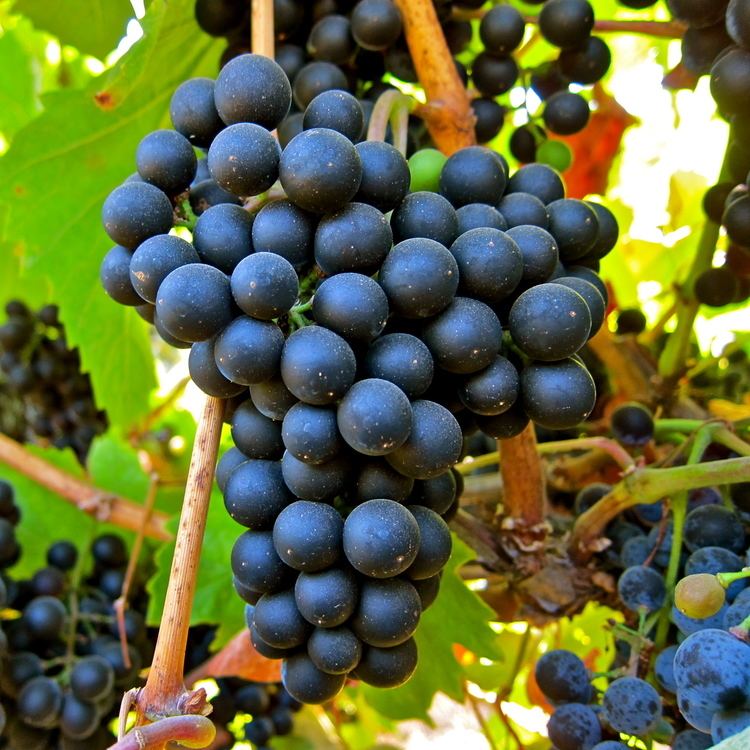Color of berry skin Rouge Also called Verdot (more) Wine color Red Wine | Notable wines Château Palmer Sweetness of resulting wine Dry | |
 | ||
Scientific name Vitis vinifera 'Petit Verdot' Similar Cabernet Franc, Common Grape Vine, Merlot, Cabernet Sauvignon, Malbec | ||
Jordan winery petit verdot vineyard grape thinning winemaking experiment
Petit Verdot is a variety of red wine grape, principally used in classic Bordeaux blends. It ripens much later than the other varieties in Bordeaux, often too late, so it fell out of favour in its home region. When it does ripen it adds tannin, colour and flavour, in small amounts, to the blend. Petit verdot has attracted attention among winemakers in the New World, where it ripens more reliably and has been made into single varietal wine. It is also useful in 'stiffening' the mid palate of Cabernet Sauvignon blends.
Contents
- Jordan winery petit verdot vineyard grape thinning winemaking experiment
- How to make homemade wine from grapes petit verdot
- History
- Argentina
- Australia
- Chile
- France
- Italy
- Peru
- Portugal
- USA
- Vine and Viticulture
- Synonyms
- References
When young its aromas have been likened to banana and pencil shavings. Strong tones of violet and leather develop as it matures.
How to make homemade wine from grapes petit verdot
History
Petit Verdot probably predates Cabernet Sauvignon in Bordeaux, but its origins are unclear. There are records of it in the eighteenth century, but its characteristics suggest an origin in much hotter climes than the Gironde.
It is one parent of Tressot, the other parent being Duras, a grape from the upper Tarn valley near Toulouse. It's possible that both were brought to the region by the Romans as they moved inland from the Mediterranean.
Argentina
There are some blocks of Petit Verdot in Argentina, although for many years it was labelled as Fer.
Australia
Verdot was included in James Busby's collection of 1832, and it was trialled by Sir William Macarthur in the 1840s. In 2000 there were 1600 hectares in Australia with Kingston Estate in South Australia having the largest planting, four times more than in France. It is increasingly being used to make massive, brooding, single varietal wines that will age for several years - Pirramimma has championed this approach.
Chile
Chile had 137 ha in 2003.
France
Almost all the Petit Verdot in France is planted in Bordeaux, mostly in the Médoc where it is used in small amounts to give structure to the classic Bordeaux blend. However the late ripening means that in some years the entire crop is lost and it only properly ripens once every four years, so it has fallen out of favour, particularly with the trend towards earlier-maturing wine. Château Palmer is unusual in having up to 6% Petit Verdot in its blend, which helps stiffen the high proportion of Merlot in their wines. 1-3% is more usual.
Italy
In Italy it is sometimes cultivated in Maremma (Tuscany) and Lazio.
Peru
In Peru, Petit Verdot vines are grown in the southern Ica Region. The desert weather from Ica allows producers to make 100% varietal Petit Verdot wines. "Tacama" winery produces one its high end wines, "Don Manuel" with 100% Petit Verdot grapes.
Portugal
In Portugal is sometime cultivated in Alentejo with great results due to this region's specific climatic conditions.
USA
The profusion of Meritage Bordeaux blends has seen considerable interest in the variety in California, where there was 360 ha in 2003. The more consistent, warmer climate is a big help in reliably ripening the grape, and producers are starting to experiment with single varietals. It is also planted in a small way in Arizona, Colorado, Texas, Virginia, Missouri, North Carolina, Long Island, New York and Washington.
In addition to the countries above, Petit Verdot is used as 'seasoning' in Bordeaux-style blends in British Columbia, New Zealand, South Africa and Spain.
Vine and Viticulture
The leaves have 3-5 lobes with a distinctively elongated central lobe. The small, cylindrical bunches are winged, with small black berries.
The name Petit Verdot ('small green') refers to one of the main problems with the grape, that often the berries fail to develop properly without the right weather during flowering. It also refers to the late ripening which usually comes too late for the Bordeaux climate. Petit Verdot also has a peculiar characteristic in that it produces more than two clusters per shoot.
Synonyms
Bouton, Carmelin, Heran, Lambrusquet Noir, Petit Verdau, Petit Verdot Noir, Verdot and Verdot Rouge.
